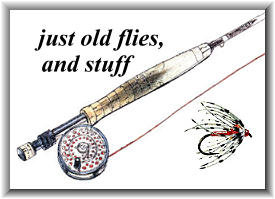John McBride says, "This is one of my family's handed-down versions of Charles
Cotton's Trout Fly patterns from the 5th edition of the Complete Angler,
using newer materials of course."
Charles Cotton Owl - Dressing as shown
Body: White, thin, and very small.
Wings: Medium dun gray.
Owl Fly from the original:
June, from the twelfth to the four-and-twentieth, late at night.
Dubbing for the body made of a weasel's tail.
Wing of white/grey.

"Charles Cotton was a teenager during the Civil War, and was nineteen when the King
was executed at Whitehall. He seems to have had a liberal education, and it is thought
that he went to Cambridge. He was familiar with French and Italian as well as the Classics.
He was well educated, handsome and a great dinner companion, prized for his wit and
conversation, though he could also be quarrelsome and something of a firebrand. He
married his cousin Isabella Hutchinson in 1656, when he was 26. Two years later, on the
death of his father, Charles inherited the estates of Beresford and Bentley, which are on
the Staffordshire and Derbyshire border. The river Dove flowed nearby and it was here that
he learnt to fly fish. He published his first piece the same year, a panegyric celebrating the
coronation of Charles II. In 1664 he published a burlesque titled Scarronides,
a popular and slightly pornographic work which ran to 14 editions. His wife died in
1670, leaving him with three sons and five daughters, but he married again five years
later, to the widow of the Earl of Ardglass, a match which may have
been an attempt to restore his fortunes, which
had declined alarmingly under the pressure of his lifestyle.
After the restoration, Cotton divided his time between London and Beresford, receiving a
commission in the King's forces. We do not know how he met [Izaak]Walton, although the latter
grew up in Staffordshire and there is some evidence that Cotton was known to Walton
many years before their collaboration on the Compleat Angler. Cotton certainly fished with
Izaac Walton a great deal in later years, and built a fishing house on the banks of the Dove,
the work being undertaken in 1674 (the hut still stands, despite rumours to the contrary).
Cotton and Walton's initials were carved into a stone set above the door, below the
inscription piscatoribus sacrum. At Walton's request, Cotton wrote his celebrated second
part of the Compleat Angler two years after the completion of the fishing house. The work
was the first detailed treatise on fly fishing, appearing in the fifth edition of the Compleat
Angler, and has on the title page the same monogram as the one set above the door of the
fishing house itself. Walton was 83 in that year; it isn't clear whether he ever mastered fly
fishing, and it is quite likely that his days on the Dove were spent dapping live Mayfly.
 Besides being a fly fisherman, Cotton wrote some fairly bawdy poetry (the years haven't
treated it kindly, and it would hardly raise an eyebrow if posted on the Internet these
days), translated various books from the French, and wrote The Compleat Gamester
(1674). His poetry continued to be popular throughout the eighteenth century and some
was addressed to Walton. [You can read one of Cotton's poems in our
Lighterside/Poet's Creek section.]
Besides being a fly fisherman, Cotton wrote some fairly bawdy poetry (the years haven't
treated it kindly, and it would hardly raise an eyebrow if posted on the Internet these
days), translated various books from the French, and wrote The Compleat Gamester
(1674). His poetry continued to be popular throughout the eighteenth century and some
was addressed to Walton. [You can read one of Cotton's poems in our
Lighterside/Poet's Creek section.]
Cotton's later years were marred by financial difficulties. He petitioned Parliament twice to
sell parts of his estate and although his literary efforts continued, his income from
published works was insufficient to allow him to make ends meet and he had to sell
Beresford Hall in 1681. He is buried in St. James' church, Picadilly."
Credits: Quoted text and drawing of Cotton from
www.flyfishinghistory.com/ ( Dr. Andrew N. Herd), Photo of gravestone,
by David Conway, fly photos from http://flytyingworld.com. ~ DLB
|



 Besides being a fly fisherman, Cotton wrote some fairly bawdy poetry (the years haven't
treated it kindly, and it would hardly raise an eyebrow if posted on the Internet these
days), translated various books from the French, and wrote The Compleat Gamester
(1674). His poetry continued to be popular throughout the eighteenth century and some
was addressed to Walton. [You can read one of Cotton's poems in our
Besides being a fly fisherman, Cotton wrote some fairly bawdy poetry (the years haven't
treated it kindly, and it would hardly raise an eyebrow if posted on the Internet these
days), translated various books from the French, and wrote The Compleat Gamester
(1674). His poetry continued to be popular throughout the eighteenth century and some
was addressed to Walton. [You can read one of Cotton's poems in our